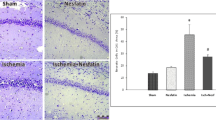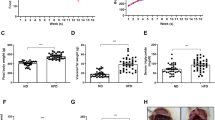Abstract
In the present study, we investigated the effects of pioglitazone (PGZ) in the hippocampal CA1 region of low- or high-fat diet (LFD or HFD) fed gerbils after transient forebrain ischemia. After 8 weeks of LFD or HFD feeding, PGZ (30 mg/kg) was intraperitoneally administered to the gerbils, following which ischemia was induced by occlusion of the bilateral common carotid arteries for 5 min. Administration of PGZ significantly reduced the ischemia-induced hyperactivity 1 day after ischemia/reperfusion in both LFD- and HFD-fed gerbils. At 4 days after ischemia/reperfusion, the neurons were significantly reduced and microglial activation was observed in the hippocampal CA1 region in LFD- and HFD-fed gerbils. The microglial activation was more prominent in the HFD-fed gerbils compared to the LFD-fed gerbils. Administration of PGZ ameliorated ischemia-induced neuronal death and microglial activation in the hippocampal CA1 region 4 days after ischemia/reperfusion in the LFD-fed gerbils, but not in the HFD-gerbils. At 6 h after ischemia/reperfusion, tumor necrosis factor-α (TNF-α) and interlukin-1β (IL-1β) levels were significantly increased in the hippocampal homogenates of LFD-fed group compared to control group, and HFD feeding further increased TNF-α and IL-1β levels. PGZ treatment significantly ameliorated the increase of TNF-α and IL-1β levels in LFD-fed gerbils, not in the HFD-fed gerbils. At 12 h after ischemia/reperfusion, superoxide dismutase (SOD) and malondialdehyde (MDA) levels in hippocampal homogenates were significantly increased in the LFD-fed group compared to the control group, and HFD feeding significantly showed relatively reduction in SOD activity and increase in MDA level. PGZ administration significantly reduced the increase in MDA levels 12 h after ischemia/reperfusion in the LFD-fed gerbils, but not in the HFD-fed gerbils. These results suggest that PGZ ameliorates the neuronal damage induced by ischemia by maintaining the TNF-α, IL-1β, SOD and MDA levels in LFD-fed gerbils. In addition, HFD feeding affects the modulation of these parameters in the hippocampus after transient forebrain ischemia.






Similar content being viewed by others
References
OECD (2014) Available online at http://www.oecd.org/els/health-systems/Obesity-Update-2014.pdf
Pannacciulli N, Del Parigi A, Chen K, Le DS, Reiman EM, Tataranni PA (2006) Brain abnormalities in human obesity: a voxel-based morphometric study. Neuroimage 31:1419–1425
Deutsch C, Portik-Dobos V, Smith AD, Ergul A, Dorrance AM (2009) Diet-induced obesity causes cerebral vessel remodeling and increases the damage caused by ischemic stroke. Microvasc Res 78:100–106
Didion SP, Lynch CM, Faraci FM (2007) Cerebral vascular dysfunction in TallyHo mice: a new model of Type II diabetes. Am J Physiol Heart Circ Physiol 292:H1579–H1583
Kitayama J, Faraci FM, Lentz SR, Heistad DD (2007) Cerebral vascular dysfunction during hypercholesterolemia. Stroke 38:2136–2141
Osmond JM, Mintz JD, Dalton B, Stepp DW (2009) Obesity increases blood pressure, cerebral vascular remodeling, and severity of stroke in the Zucker rat. Hypertension 53:381–386
Osmond JM, Mintz JD, Stepp DW (2010) Preventing increased blood pressure in the obese Zucker rat improves severity of stroke. Am J Physiol Heart Circ Physiol 299:H55–H61
Elias MF, Elias PK, Sullivan LM, Wolf PA, D’Agostino RB (2003) Lower cognitive function in the presence of obesity and hypertension: the Framingham heart study. Int J Obes Relat Metab Disord 27:260–268
Winocur G, Greenwood CE (2005) Studies of the effects of high fat diets on cognitive function in a rat model. Neurobiol Aging 26(Suppl 1):46–49
Hwang IK, Kim IY, Kim DW et al (2008) Strain-specific differences in cell proliferation and differentiation in the dentate gyrus of C57BL/6N and C3H/HeN mice fed a high fat diet. Brain Res 1241:1–6
Hwang IK, Kim IY, Kim YN et al (2009) Comparative study on high fat diet-induced 4-hydroxy-2E-nonenal adducts in the hippocampal CA1 region of C57BL/6N and C3H/HeN mice. Neurochem Res 34:964–972
Nguyen JC, Killcross AS, Jenkins TA (2014) Obesity and cognitive decline: role of inflammation and vascular changes. Front Neurosci 8:375
Kanoski SE, Davidson TL (2011) Western diet consumption and cognitive impairment: links to hippocampal dysfunction and obesity. Physiol Behav 103:59–68
Moreno S, Farioli-Vecchioli S, Cerù MP (2004) Immunolocalization of peroxisome proliferator-activated receptors and retinoid X receptors in the adult rat CNS. Neuroscience 123:131–145
Hubert HB, Feinleib M, McNamara PM, Castelli WP (1983) Obesity as an independent risk factor for cardiovascular disease: a 26-year follow-up of participants in the Framingham Heart Study. Circulation 67:968–977
Roger VL, Go AS, Lloyd-Jones D et al (2012) Heart disease and stroke statistics—2012 update: a report from the American Heart Association. Circulation 125:e2–e220
Kumari R, Willing LB, Patel SD et al (2010) The PPAR-γ agonist, darglitazone, restores acute inflammatory responses to cerebral hypoxia-ischemia in the diabetic ob/ob mouse. J Cereb Blood Flow Metab 30:352–360
Vannucci SJ, Willing LB, Goto S et al (2001) Experimental stroke in the female diabetic, db/db, mouse. J Cereb Blood Flow Metab 21:52–60
Arvanitidis AP, Corbett D, Colbourne F (2009) A high fat diet does not exacerbate CA1 injury and cognitive deficits following global ischemia in rats. Brain Res 1252:192–200
Li W, Prakash R, Chawla D et al (2013) Early effects of high-fat diet on neurovascular function and focal ischemic brain injury. Am J Physiol Regul Integr Comp Physiol 304:R1001–R1008
Yan BC, Park JH, Ahn JH et al (2014) Effects of high-fat diet on neuronal damage, gliosis, inflammatory process and oxidative stress in the hippocampus induced by transient cerebral ischemia. Neurochem Res 39:2465–2478
Collino M, Aragno M, Mastrocola R et al (2006) Modulation of the oxidative stress and inflammatory response by PPAR-γ agonists in the hippocampus of rats exposed to cerebral ischemia/reperfusion. Eur J Pharmacol 530:70–80
Chen K, Li D, Zhang X, Hermonat PL, Mehta JL (2004) Anoxia-reoxygenation stimulates collagen type-I and MMP-1 expression in cardiac fibroblasts: modulation by the PPAR-γ ligand pioglitazone. J Cardiovasc Pharmacol 44:682–687
Zhao Y, Patzer A, Herdegen T, Gohlke P, Culman J (2006) Activation of cerebral peroxisome proliferator-activated receptors gamma promotes neuroprotection by attenuation of neuronal cyclooxygenase-2 overexpression after focal cerebral ischemia in rats. FASEB J 20:1162–1175
Lee KJ, Jang YH, Lee H, Yoo HS, Lee SR (2008) PPARγ agonist pioglitazone reduces neuronal cell damage after transient global cerebral ischemia through matrix metalloproteinase inhibition. Eur J Neurosci 27:334–342
Kaundal RK, Iyer S, Kumar A, Sharma SS (2009) Protective effects of pioglitazone against global cerebral ischemic-reperfusion injury in gerbils. J Pharmacol Sci 109:361–367
Maeshiba Y, Kiyota Y, Yamashita K, Yoshimura Y, Motohashi M, Tanayama S (1997) Disposition of the new antidiabetic agent pioglitazone in rats, dogs, and monkeys. Arzneimittelforschung 47:29–35
Nam HG, Kim W, Yoo DY et al (2013) Chronological changes and effects of AMP-activated kinase in the hippocampal CA1 region after transient forebrain ischemia in gerbils. Neurol Res 35:395–405
Janać B, Radenović L, Selaković V, Prolić Z (2006) Time course of motor behavior changes in Mongolian gerbils submitted to different durations of cerebral ischemia. Behav Brain Res 175:362–373
Loskota WA, Lomax P, Verity MA (1974) A stereotaxic atlas of the Mongolian gerbil brain (Meriones unguiculatus). Ann Arbor Science Publishers Inc., Ann Arbor, pp 70–79
Saito K, Suyama K, Nishida K, Sei Y, Basile AS (1996) Early increases in TNF-α, IL-6 and IL-1β levels following transient cerebral ischemia in gerbil brain. Neurosci Lett 206:149–152
Beauchamp C, Fridovich I (1971) Superoxide dismutase: improved assays and an assay applicable to acrylamide gels. Anal Biochem 44:276–287
Yoo DY, Kim W, Lee CH et al (2012) Melatonin improves d-galactose-induced aging effects on behavior, neurogenesis, and lipid peroxidation in the mouse dentate gyrus via increasing pCREB expression. J Pineal Res 52:21–28
Kernan WN, Inzucchi SE (2004) Type 2 diabetes mellitus and insulin resistance: stroke prevention and management. Curr Treat Options Neurol 6:443–450
Toni D, Sacchetti ML, Argentino C et al (1992) Does hyperglycaemia play a role on the outcome of acute ischaemic stroke patients? J Neurol 239:382–386
Mercer NJ, Holub BJ (1979) Response of free and esterified plasma cholesterol levels in the Mongolian gerbil to the fatty acid composition of dietary lipid. Lipids 14:1009–1014
Bartizal KF Jr, Beaver MH, Wostmann BS (1982) Cholesterol metabolism in gnotobiotic gerbils. Lipids 17:791–797
Pelleymounter MA, Cullen MJ, Baker MB et al (1995) Effects of the obese gene product on body weight regulation in ob/ob mice. Science 269:540–543
Laposky AD, Shelton J, Bass J, Dugovic C, Perrino N, Turek FW (2006) Altered sleep regulation in leptin-deficient mice. Am J Physiol Regul Integr Comp Physiol 290:R894–R903
Culman J, Nguyen-Ngoc M, Glatz T, Gohlke P, Herdegen T, Zhao Y (2012) Treatment of rats with pioglitazone in the reperfusion phase of focal cerebral ischemia: a preclinical stroke trial. Exp Neurol 238:243–253
Lee CH, Park OK, Yoo KY et al (2011) The role of peroxisome proliferator-activated receptor γ, and effects of its agonist, rosiglitazone, on transient cerebral ischemic damage. J Neurol Sci 300:120–129
Langdon KD, Clarke J, Corbett D (2011) Long-term exposure to high fat diet is bad for your brain: exacerbation of focal ischemic brain injury. Neuroscience 182:82–87
Sundararajan S, Gamboa JL, Victor NA, Wanderi EW, Lust WD, Landreth GE (2005) Peroxisome proliferator-activated receptor-γ ligands reduce inflammation and infarction size in transient focal ischemia. Neuroscience 130:685–696
Mrak RE, Sheng JG, Griffin WS (1995) Glial cytokines in Alzheimer’s disease: review and pathogenic implications. Hum Pathol 26:816–823
Del Zoppo GJ (2010) The neurovascular unit in the setting of stroke. J Intern Med 267:156–171
Zhu Y, Saito K, Murakami Y, Asano M, Iwakura Y, Seishima M (2006) Early increase in mRNA levels of pro-inflammatory cytokines and their interactions in the mouse hippocampus after transient global ischemia. Neurosci Lett 393:122–126
Hwang IK, Yoo KY, Kim DW et al (2006) Ionized calcium-binding adapter molecule 1 immunoreactive cells change in the gerbil hippocampal CA1 region after ischemia/reperfusion. Neurochem Res 31:957–965
Drew PD, Johnson JW, Douglas JC, Phelan KD, Kane CJ (2015) Pioglitazone blocks ethanol induction of microglial activation and immune responses in the hippocampus, cerebellum, and cerebral cortex in a mouse model of fetal alcohol spectrum disorders. Alcohol Clin Exp Res 39:445–454
Dobrian AD, Schriver SD, Khraibi AA, Prewitt RL (2004) Pioglitazone prevents hypertension and reduces oxidative stress in diet-induced obesity. Hypertension 43:48–56
Hwang IK, Eum WS, Yoo KY et al (2005) Copper chaperone for Cu, Zn-SOD supplement potentiates the Cu, Zn-SOD function of neuroprotective effects against ischemic neuronal damage in the gerbil hippocampus. Free Radic Biol Med 39:392–402
Kim DW, Lee SH, Jeong MS et al (2010) Transduced Tat-SAG fusion protein protects against oxidative stress and brain ischemic insult. Free Radic Biol Med 48:969–977
Yoo DY, Kim W, Nam SM et al (2014) Neuroprotective effects of Z-ajoene, an organosulfur compound derived from oil-macerated garlic, in the gerbil hippocampal CA1 region after transient forebrain ischemia. Food Chem Toxicol 72:1–7
Acknowledgments
This work was supported by the National Research Foundation of Korea Grant funded by the Korean Government (MEST), Republic of Korea (2010-0021445).
Author information
Authors and Affiliations
Corresponding author
Rights and permissions
About this article
Cite this article
Moon, S.M., Choi, GM., Yoo, D.Y. et al. Differential Effects of Pioglitazone in the Hippocampal CA1 Region Following Transient Forebrain Ischemia in Low- and High-Fat Diet-Fed Gerbils. Neurochem Res 40, 1063–1073 (2015). https://doi.org/10.1007/s11064-015-1568-3
Received:
Revised:
Accepted:
Published:
Issue Date:
DOI: https://doi.org/10.1007/s11064-015-1568-3




